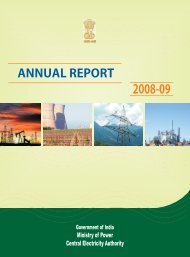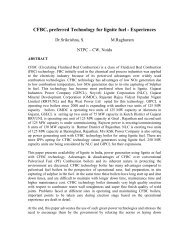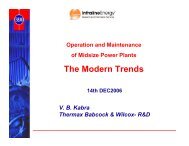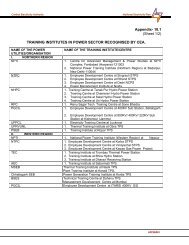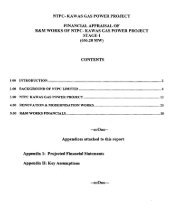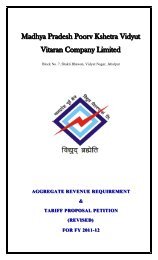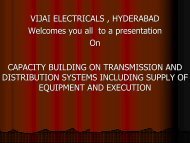thermal power development - Infraline
thermal power development - Infraline
thermal power development - Infraline
Create successful ePaper yourself
Turn your PDF publications into a flip-book with our unique Google optimized e-Paper software.
Central electricity authority Annual Report 2009-10<br />
4.3 Optimum Utilization of available<br />
Generating Capacity - Inter<br />
Regional Exchanges of Power<br />
Northern, Western, Eastern and North-<br />
Eastern Grid (NEW Grid) with an installed<br />
generating capacity of 1,16,022 MW as on<br />
31.03.2010 and peak load of 91,748 MW<br />
for the year 2009-10 are connected through<br />
synchronous links. Southern Region, with<br />
an installed generating capacity of 43300.5<br />
MW as on 31.03.2010 and peak load of<br />
32,178 MW for the year 2009-10 is connected<br />
with Eastern Region and Western Region<br />
through asynchronous HVDC links. The total<br />
inter-Regional transmission capacity as on<br />
31.03.2010 is 20,750 MW which includes<br />
132/110 kV Inter-regional link of 600 MW<br />
capacity. The <strong>power</strong> transfer capacity as on<br />
31.03.2010 was 6,330 MW between Eastern<br />
Region and Northern Region, 2,990 MW<br />
between Eastern Region and Western Region,<br />
3,630 MW between Eastern Region and<br />
Southern Region, 1,260 MW between Eastern<br />
Region and North Eastern Region, 4,220 MW<br />
between Western Region and Northern Region<br />
and 1,720 MW between Western Region and<br />
Southern Region. Synchronous operation of the<br />
Northern, Western, Eastern and North-Eastern<br />
Regional Grids and asynchronous operation of<br />
the Combined Grid with the Southern Grids<br />
helped in export of surplus/ unutilised <strong>power</strong><br />
across various Regions.<br />
All regional grids experienced shortages<br />
of varying degrees as well as some seasonal /<br />
off-peak surpluses. These surpluses were<br />
exported by surplus States to deficit State.<br />
During 2009-10, Eastern Region was the net<br />
exporter, whereas Northern, Western, Southern<br />
and North-Eastern Regions were net importers<br />
of <strong>power</strong>. Himachal Pradesh and J&K in<br />
Northern Region, Goa, Gujarat and DNH &<br />
Daman Diu in Western Region, Jharkhand,<br />
"Electricity is life: Conserve it."<br />
Bihar and Damodar Valley Corporation in Eastern<br />
Region, Arunachal Pradesh, Manipur, Mizoram,<br />
Nagaland and Tripura in North- Eastern Region<br />
and Puducherry in Southern Region were net<br />
exporters of <strong>power</strong> during this period.<br />
Govt. of India (GoI) has set up Central<br />
Generating Stations (CGS) through GoI<br />
Undertakings, viz. NTPC Ltd., National Hydro<br />
Power Corporation Ltd. (NHPC), Satluj Jal<br />
Vidut Nigam Ltd. (SJVNL), Neyveli Lignite<br />
Corp. (NLC), Nuclear Power Corporation (NPC)<br />
etc. Except for few stations dedicated to the host<br />
State, output of CGS is allocated to various<br />
States. About 85% of the installed capacity is<br />
allocated as firm shares, whereas about 15%<br />
is the unallocated quota, which is allocated by<br />
GoI from time to time depending upon relative<br />
shortages and contingent conditions. CEA keeps<br />
a close watch on the <strong>power</strong> supply position<br />
and recommends to the Ministry of Power the<br />
quantum of allocation from the unallocated<br />
quota. CEA also coordinates the implementation<br />
of the allocation through the Regional Power<br />
Committees.<br />
Open Access is a key provision in the<br />
Electricity Act, 2003 for utilisation of <strong>power</strong> in<br />
surplus areas by needy States/utilities in deficit<br />
areas, besides bringing about competition and<br />
enhance efficiency. All such transactions took<br />
place through the provision of Short Term Open<br />
Access (STOA) though CERC has also made<br />
provisions for Medium Term Open Access<br />
(MTOA). The inter-regional energy exchanges,<br />
which included the long-term and short-term<br />
open access transactions, were 26464 MU<br />
during the year 2009-10, as compared to 23405 MU<br />
during the previous year, showing a growth of<br />
13.1%. The inter-regional exchanges helped a<br />
number of States / utilities in all the Regions to<br />
bridge the gap between demand and supply of<br />
<strong>power</strong>. Details of Inter-regional exchanges of<br />
energy among the Regions during 2008-09 and<br />
2009-10 are given below:<br />
47



